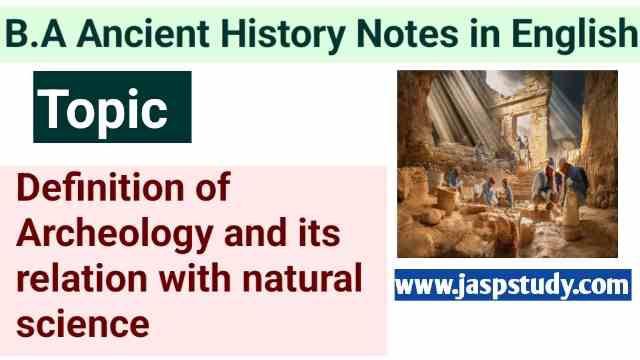What is the definition of archaeology ? how is it related with natural science?
OR
Write the definition of archaeology and discuss its relation with natural science.
Definition of Archaeology and its relation with natural science: In this article we will discuss about Definition of Archaeology and its relation with natural science. For exam perspective Definition of Archaeology and its relation with natural science.Archaeology is very importent topic.
Definition of Archaeology:
Archaeology is the scientific study of human history and prehistory, focusing on the recovery and analysis of material remains left by past human societies. These remains include artifacts, structures, and other physical evidence, such as bones, tools, pottery, and dwellings. By examining these traces, archaeologists aim to reconstruct and understand the ways in which ancient people lived, interacted, and evolved over time. Archaeology seeks not only to document the material culture of past civilizations but also to interpret the social, cultural, economic, and environmental contexts in which these people existed.
The word “archaeology” is derived from the Greek words archaios, meaning “ancient,” and logos, meaning “study” or “discourse.” As a discipline, archaeology bridges multiple fields, including anthropology, history, art history, and natural sciences, enabling a holistic view of the past. It is primarily concerned with societies that have left no written records, but it also complements the study of historical periods by providing physical evidence that can help interpret historical narratives.
Archaeology is often divided into several sub-disciplines, such as prehistoric archaeology, historical archaeology, classical archaeology, and underwater archaeology, each focusing on different periods, geographical regions, or types of sites. Prehistoric archaeology, for instance, deals with societies that existed before the advent of writing, while historical archaeology examines sites from periods where written records exist.
Read Also
Salient features of Vedic Culture
Achievements of Mahapadmananda
Rise of Magadha Empire from Bimbisara to Mahapadmananda
Salient features of Assyrian Civilization
Relation with Natural Science:
Archaeology and natural science are deeply interconnected. Archaeology uses a range of scientific methods and tools to analyze physical remains, making natural science a crucial component in interpreting and understanding the past. By applying techniques from disciplines such as geology, biology, chemistry, physics, and environmental science, archaeologists can derive more precise and reliable conclusions about ancient civilizations. This interdisciplinary approach allows for a more comprehensive understanding of human history, especially in areas where written records are scarce or nonexistent.
Here are some key ways in which archaeology is connected to natural science:
Geology
Archaeologists use geological principles to study the stratigraphy (layers of soil or sediment) in excavation sites. The principles of stratigraphy help in dating artifacts and understanding the environmental conditions in which past human activities took place.
Botany and Paleobotany
Archaeologists use plant remains, such as seeds or pollen, to understand ancient environments, diet, and agriculture. Paleobotany (the study of ancient plant life) helps to reconstruct past climates and ecosystems.
Zoology and Palaeozoology
The study of animal remains in archaeological sites reveals insights into the diets of ancient peoples, their hunting practices, and their relationship with animals. Paleozoology helps to identify extinct species and understand the animal life of past eras.
Chemistry
Chemistry has revolutionized archaeological research by providing reliable methods for dating artifacts and organic materials. One of the most widely used techniques is radiocarbon dating, which measures the amount of carbon-14 in organic materials. Since carbon-14 decays at a known rate, scientists can calculate the age of materials such as bones, wood, and charcoal. This allows archaeologists to establish the age of objects and place them within a specific historical framework.
In addition to radiocarbon dating, archaeologists use other methods such as thermoluminescence dating and optically stimulated luminescence (OSL) to date materials that are not carbon-based, such as ceramics or stones. These chemical techniques are essential for constructing chronological timelines of past societies and understanding the sequence of human events and developments.
Chemical analysis is also employed in the study of the composition of materials found at archaeological sites. For example, chemical analysis of pottery can help identify the types of clay used in its manufacture, revealing information about ancient trade routes and the exchange of goods. Chemical residue analysis, such as lipid analysis on ancient pottery, can provide insights into ancient diets and food preparation methods.
Physics
Physics plays an important role in archaeology through various technological tools used to analyze materials and artifacts. Non-invasive techniques like ground-penetrating radar (GPR) allow archaeologists to map buried structures or features without digging, providing valuable data without disturbing the site. GPR works by sending electromagnetic waves into the ground, which bounce back when they encounter different materials, allowing archaeologists to visualize subsurface features.
Another example of physics in archaeology is neutron activation analysis (NAA), a method used to determine the elemental composition of materials like pottery, metals, or ceramics. NAA helps archaeologists trace the origins of raw materials and understand ancient trade networks, as the chemical signature of a material can reveal its geographic source.
Thermoluminescence dating is another physics-based technique used to date materials, particularly ceramics. It measures the amount of light released when minerals are heated and can determine when the material was last exposed to sunlight or heat, providing age estimates for artifact.
Environmental Science
Environmental reconstruction through pollen analysis, sediment analysis, and isotopic studies allows archaeologists to infer past climates and ecosystems. This also helps understand how ancient societies adapted to their environments and the impact they had on the landscape.
Conclusion
In conclusion, archaeology is a deeply interdisciplinary field that relies heavily on the natural sciences to enhance its understanding of past human societies. By integrating methods and techniques from geology, biology, chemistry, physics, and environmental science, archaeologists can more accurately reconstruct the past. These scientific approaches provide the tools to date artifacts, analyze ancient environments, and understand the relationships between humans and their surroundings. The collaboration between archaeology and the natural sciences allows for a more nuanced and comprehensive understanding of human history and evolution, enriching our knowledge of the ancient world and its connection to modern life.

